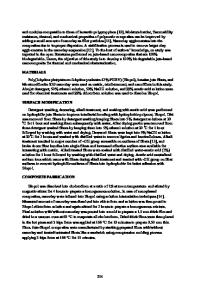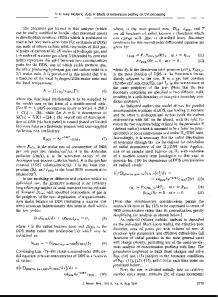Development & Characterization of Green Composites Using Novel 3D Woven Preforms
- PDF / 3,989,783 Bytes
- 13 Pages / 439.37 x 666.142 pts Page_size
- 104 Downloads / 343 Views
Development & Characterization of Green Composites Using Novel 3D Woven Preforms Yasir Nawab 1 & Muhammad Kashif 1,2 & Muhammad Ayub Asghar 1 & Ali Asghar 2 & Muhammad Umair 1 & Khubab Shaker 1 & Muhammad Zeeshan 1
Received: 3 May 2018 / Accepted: 27 June 2018 # Springer Nature B.V. 2018
Abstract Green composites are the emerging materials made using natural fibers and environmentally degradable matrix such as green epoxy. Natural fiber composites are the motivation of researchers for low to medium impact applications as well as structural applications like automobiles. In this research work, 3D orthogonal layer to layer (LL) and through the thickness (TT) woven structures with different interlocking patterns, used as preforms in composites are presented. The mechanical properties of preform as well as associated composites are studied on equivalent fiber volume fraction. Jute yarn was woven into four layered 3D woven structures. The use of bridgeable and sustainable fiber, with its prospective use with the biodegradable matrix, is the objective of this work. The focus of this study is to improve mechanical performance by changing weave pattern, so that the resulting composite is robust in design. Keywords Warp and weft interlocks . Hybrid interlocks . 3D woven composites . Green composites
1 Introduction Natural fibers having low cost, equally good mechanical properties, high specific strength, environmental friendly and bio-degradable characteristics, make them attractive for composite
* Yasir Nawab [email protected]
1
National Center for Composite Materials, Faculty of Engineering and Technology, National Textile University, Faisalabad, Pakistan
2
Department of Textile Engineering, Faculty of Engineering and Architecture, Baluchistan University of Information Technology, Engineering and Management Sciences, Quetta, Pakistan
Appl Compos Mater
manufacturing. Control over the weight and mechanical properties of woven structures are attractive for use in composites [1]. 3D woven composites perform better [2] than laminated composites due to their better through-thickness properties [3]. In laminated composites, the perpendicular direction to the plane of the ply exhibits very low stiffness and strength. 3D fabric reinforcements can solve the difficulty of poor interlaminar strength. 3D has different forms like single-layer materials with an overall shape, multilayer’s hollow materials, solid planar materials having multiple layers and solid multilayers materials with an overall 3D shape. 3D woven fabric composites have enhanced mechanical properties as compared to conventional 2D woven laminates [4]. These reinforcements or preforms are economical for textile-based composite. Textile preform structures have important performance feature, in transforming reinforcement characteristics to product performance. Such preforms are considered to be a structural support for mechanical performance and as well as shape of fabricated composites [5]. Interest in few years for using 3D fabrics has grown. Their appl
Data Loading...











